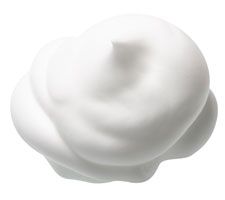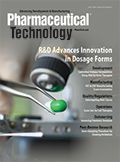Innovating Continuous Twin-Screw Granulation with Foam Delivery
Using a specific addition method to wet the powder bed in twin-screw granulation using a foam binder improves robustness for continuous solid-dosage drug product manufacturing.
Kabardins photo - stock.adobe.com

In less than a decade, foamed systems for continuous twin-screw granulation have leaped from the theoretical confines of academia onto the mainstage of industry relevance. Once viewed as a fringe technology with a lot of potential, the method of adding a foam binder during twin-screw granulation is now a commercially viable way to improve robustness.
Foam granulation introduces binding liquid into a powder bed without oversaturation; it is a tool to solve problems associated with injection wetting during twin-screw granulation. Using foam, formulators can achieve more uniformly wetted powders and increase the overall lubricity throughout the process, which minimizes both wear and tear on machinery and dissipative heating of the product on continuous manufacturing production lines.
Granulation at a glance
Continuous granulation-of which twin-screw is the most prevalent type-can streamline overall manufacturing processes by reducing costs and increasing output while still maintaining consistent product quality. Generally speaking, continuous granulation depends on a host of interconnected variables, including process temperature, screw speed and configuration, powder feed rate, and the introduction of moisture into the powder bed. If any one of those variables is improperly adjusted, the process is compromised. For example, using a liquid stream to wet the powder bed (i.e., injection wetting) can lead to issues such as uneven moisture, temperature spikes, and inconsistent component distribution.
Twin-screw granulation sets itself apart from other continuous granulation methods because of its minimal operating space. It also enhances flowability and compressibility, effectively increasing the efficiency of downstream processes, such as tablet compression or capsule filling.
As with any process, twin-screw granulation isn’t perfect. Problems with oversaturation can arise because of the confined internal operating space, which makes aerosolizing the liquid feed almost impossible. Oversaturation of the powder bed during wetting can ruin granulation, especially considering the costly demands of downstream milling and drying steps that must compensate for inadequacies in the process itself. Liquid injection streams can also lead to segregation of APIs, with substantial heterogeneity resulting in larger granules that contain more liquid due to the dominance of layering growth in a shear flow field.
Foam liquid delivery
A foam delivery system has been discovered to solve oversaturation problems associated with introducing liquids into the powder bed, but this method only works if the foam is treated as a collapsing solid when designing the twin-screw granulation process (1). By wetting the powder bed differently, many of the challenges involved in designing a twin-screw granulation process can be overcome.
The advantages of the novel foam delivery system are primarily driven by the high spread/soak ratio enabled by foam, which forces liquid to move slowly and evenly along the boundaries of gas bubbles, extending its penetration time to match the time scale of bulk mixing that occurs within the extruder. The result is improved liquid distribution in the powder bed for the short residence time distribution of this type of granulator.
Foam granulation allows for a uniform bed wetting, which prevents product temperatures from rising because of improved liquid distribution and the lubricious nature of foam. By extension, foam can protect thermally sensitive products, decrease variability, and create a more stable process.
Unlike liquid injection methods, API concentrations remain constant across the process and in the final particles when foam delivery is used, preventing segregation even when powders are highly hydrophobic. Particle size does not appear to impact API distribution as it does with liquid injection, and binder distribution (as monitored by tracer) is significantly more uniform (2). In traditional granulation, the imprecise nature of liquid injection over a deep bed of powder results in a small portion of solids getting mixed with the blade. But by implementing foam delivery within a twin-screw granulation process, the uniform wetting of a much shallower powder bed results in nearly all solids getting mixed. This combination of processes could lead formulators to novel powdered drugs that couldn’t be produced otherwise.
Because of the highly active exploration into twin-screw granulation in both academia and industry, process improvements that were previously unrealistic are now available to almost any researcher or manufacturer. These improvements are well within reach, too, as foam delivery systems can be set up at low cost using mechanical components that are already commercially available from various vendors.
Liquid penetration time experiment
To further understand the mechanism and benefits of foam granulation, consider an experiment by DuPont researchers involving two powder beds: one of pure lactose monohydrate and one containing a 50:50 blend of lactose and microcrystalline cellulose (MCC) (3). Two liquid introduction methods-droplets (analogous to liquid injection) and foam-were used. The team looked at the liquid penetration time for each of the four combinations, finding it takes approximately 100 times longer for foam to saturate a bed of powder made up of either lactose or MCC versus simply dropping liquid onto a similar bed.
Researchers began the study by sieving each formulation through a 300-µm screen. They then poured a sample of the powder (roughly 100 g) through a funnel suspended 5 cm above a glass petri dish measuring 10 cm in diameter and 1.5 cm deep. The team prepared the powder bed by evenly spreading powder around the perimeter of the dish to minimize differences in porosity between repeats. Variations in porosity using this method were observed-roughly 1.89% relative standard deviation. After preparation was complete, they added differing masses of either foam or liquid lactose monohydrate on top of the powder bed.
Researchers monitored the dispensed liquid until it fully penetrated the bed, then left the binder-saturated powder bed for 48 hours to air dry, before they removed the resulting granule nuclei. They defined the specific penetration time (tp) as the elapsed time until the binder had fully penetrated and normalized with respect to the binder mass, whereas the nucleation ratio (Km) referred to the mass of the resulting granule nuclei relative to the binder mass. This penetration study corresponds to the method devised by Hapgood and coworkers (4, 5).
The passage of liquid through the bed consistently took longer for pure lactose compared to the 50% MCC formulation because of its lower affinity for water. That difference was only statistically significant when looking at foam delivery. The difference between lactose and MCC was consistent with results reported in an earlier study (6). As previously found by Hapgood (4, 5), the smaller the dispensed binder mass on top of the powder, the longer the time needed to fully penetrate by either method of wetting to the state of powder saturation as it affects liquid mobility. The difference in the specific penetration time between foam versus droplet was significant-in fact, foam took almost two orders of magnitude longer to fully penetrate the powder than liquid. This difference is attributed to the fact that liquids drain from a semi-rigid foam more slowly, following a methodical path along the plateau borders and film walls of gas bubbles-rather than allowing all of its retained liquid to be immediately available like a droplet (7).
The researchers also found that a foam binder addition can prevent temperatures from rising because of improved liquid distribution and the lubricious nature of foam.
Commercial acceptance of foam granulation
Although continuous processing offers advantages, there is resistance in an industry that has relied on time-tested batch production processes. The pharmaceutical industry is seeing a broader range of new products in continuous hot melt extrusion using a twin-screw extruder rather than with any form of wet granulation (with a twin-screw or other technology). Research in twin-screw granulation, however, is finding some interesting developments. For example, the process naturally makes particle-size distribution that is uniquely bimodal, as opposed to the unimodal distribution made by batch processes.
Moving away from a traditional wet granulation process also opens the door for formulators to start using more hydrophobic APIs, ensuring that binders are properly distributed to accommodate a new range of difficult-to-process formulations. As more APIs become mixable, new products become available. Additionally, a reduction in water usage brings sustainability benefits to the table.
Formulators can implement foam granulation to save time compared to batch processes, because many of the steps associated with batch processing are removed from the workstream-including weighing of materials, charging of the granulator, changeovers between batches, cleaning between batches and transfer-associated issues. Furthermore, by eliminating many of the common challenges associated with proper design and implementation of liquid injection twin-screw granulation-such as proper liquid distribution and preventing in-process component segregation, for example-it is possible to arrive at the final process and formulation more quickly than before.
While in the past continuous foam granulation may have been seen as a fringe technique to hypothetically solve process-surging issues that relate to poor powder-wetting by conventional, liquid-addition methods, understanding the high spreading tendency of foam granulation now makes it a valuable technique for commercial product development.
References
1. M.R. Thompson et al., Drug Dev. Ind. Pharm. 38 (7) 771–784 (2012).
2. H. Li, M.R. Thompson, and K.P. O’Donnell, Int. J. Pharmaceutics, 496 (1) 3-11 (2015).
3. Y. Li et al., AIChE J. 61 (3) 780-791 (2015).
4. T. Nguyen, W. Shen, and K. Hapgood, Chem. Eng. Sci. 64 (24) 5210-5221 (2009).
5. M. Tan et al., Chem. Eng. Sci. 64 (12) 2826-2836 (2009).
6. K. Rocca et al., Drug Dev. Ind. Pharm. 41 (1) 35-42 (2015).
7. C. Keary and P. Sheskey, Drug Dev. Ind. Pharm. 30 (8) 831-845 (2004).
About the authors
Kevin O’Donnell is R&D manager at DuPont Nutrition & Biosciences; Michael Thompson is Professor of Chemical Engineering, McMaster University.
Article Details
Pharmaceutical Technology
Vol. 44, No. 7
July 2020
Pages: 30–33
Citation
When referring to this article, please cite it as K. O’Donnell and M. Thompson, "Innovating Continuous Twin-Screw Granulation with Foam Delivery," Pharmaceutical Technology 44 (7) 2020.

Drug Solutions Podcast: A Closer Look at mRNA in Oncology and Vaccines
April 30th 2024In this episode fo the Drug Solutions Podcast, etherna’s vice-president of Technology and Innovation, Stefaan De Koker, discusses the merits and challenges of using mRNA as the foundation for therapeutics in oncology as well as for vaccines.
Entering New Domains for 3D Printing of Drug Products
April 6th 20253D printing of personalized medications is currently possible under existing compounding regulations, offering enhanced process control through automation. But new legislation coming in 2025 will allow 3D printing as part of a distributed manufacturing framework.